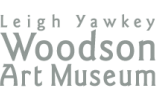And, I have artists’ statements on my mind! *
125 of them to be precise.
Why? It’s Birds in Artcatalogue production time and that means everyone at the Woodson Art Museum – as well as the 125 artists included in the 2012 exhibition – is working fast and furiously to tend to each and every detail to ensure the best possible publication.
Design, layout and page set-ups, and color proofing require the attention of other staff members. I’m all about words right now . . . artists’ words.
 Writing an artist’s statement isn’t easy, and I know it’s not the “fun” part of being an artist either. As professional museum curators and educators, we want to provide insights for catalogue readers as well as visitors (we include artists’ statements on Birds in Art gallery labels). We know our audience enjoys learning about an artist’s creative process, inspirations, and techniques. One of these points of access is super; all three can help us engage people with art, which is what forward-thinking, pro-active museums do day after day.
Writing an artist’s statement isn’t easy, and I know it’s not the “fun” part of being an artist either. As professional museum curators and educators, we want to provide insights for catalogue readers as well as visitors (we include artists’ statements on Birds in Art gallery labels). We know our audience enjoys learning about an artist’s creative process, inspirations, and techniques. One of these points of access is super; all three can help us engage people with art, which is what forward-thinking, pro-active museums do day after day.While statements may be difficult for artists to write, editing them isn’t easy either. In addition to ensuring that what we publish conforms to the Museum’s “style sheet” (this is the easy part), I’m a stickler for the following: does the statement provide insight or enlighten; do the words makes sense or are they just strung together; and does the statement do justice to the artwork by adding something to the equation.
I don’t want to stress anyone further – not the artists responsible for crafting statements, nor myself. Apparently, I’m not the only one thinking about artists’ statements these days.
The June/July issue of American Craft magazine includes an excellent Q & A under the heading, “When Artists Write About Their Work.” The queries answered are threefold: what is the purpose of an artist’s statement; what are the elements of the ideal statement; and is it even a good idea to have artists write them.
The answers come from Glenn Adamson, head of research at London’s Victoria and Albert Museum and co-editor of the Journal of Modern Craft. Among his helpful comments are the following:
- Artists’ statements are hard to write . . . we can all agree, yes?!
- If there were no such thing as artists’ statements, only critics and art historians would write about art . . . would we be happy with that? Likely not! It’s good that artists speak for themselves.
- Adamson says for him, a good statement is “an extension of the work, rather like a museum label, not a stand-alone piece of prose.”
- Statements should encourage viewers to take a second look. Yes, indeed!
- Statements “should be honest. No posturing, no after-the-fact theorizing, no mystification.”
Anderson concludes with these words of advice, which I heartily endorse:
So if you’re in the predicament of writing an artist’s statement, try thinking of it as a particularly candid note, dashed off to an ardent admirer. After all, a love letter is tough to write, too. But who doesn’t love to get one?
I’d love to hear from artists about their statement experiences as well as from statement readers. Don’t be shy.
*In last week’s “Woodson Wanderings” post, educator Catie Anderson talked about her pre-occupation with botanicals.




